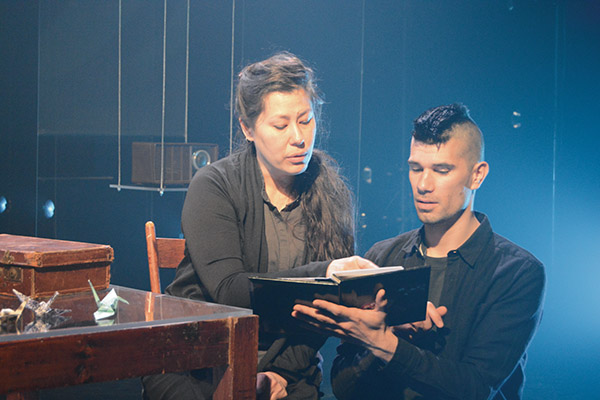The internment of Japanese Canadians during the Second World War was a shameful moment in history and one high school curricula often sideline. The Tashme Project: The Living Archives, which showed at the Centaur Nov. 15-24, brought the history of internment to the forefront. Created and performed by Julie Tamiko Manning and Matt Miwa, the production is both a reconciliatory effort of two individuals trying to reconnect with their family’s past, as well as a project meant to educate Canadians about the attempted expulsion of the Japanese community.
The Tashme Project is a verbatim theatre piece consisting of episodic scenes based on historical anecdotes. The play explores the lives of the generation of Japanese immigrants who lived in Tashme, the largest internment camp in Canada. Inspired by the disconnection that both Miwa and Manning felt from their respective family histories, the two uncover their stories as the play progresses. The anecdotes come from the leads’ relatives and acquaintances, and Miwa and Manning take on the voice and mannerisms of the individual whose stories they share. As the narrative advances, the actors immerse the audience in the experiences of families wrongfully displaced, isolated, and forced into various internment camps.
The play’s believability rests on the performers’ abilities to authentically embody the voices of a generation several times separated. Manning particularly excels in bringing a multitude of distinct ancestries to life. Through changes to her inflection and gait, she individualizes the plight of a group wrongfully judged as a homogenous whole. Meanwhile, Miwa, who doesn’t quite reach the chameleonic realism of his co-star, excels in his displays of emotional intensity. He conveys a complete affective spectrum. In one instance, he expresses the chaotic combination of an elder’s anger and sadness that emerges out of the violence of segregation. In another scene, he portrays a child’s innocent optimism amidst an increasingly hopeless environment. The actors never veer into territory of appropriation; their combined efforts instead give the effect of a live audiovisual transcription. They breathe life into the voices of a generation previously shrouded in silence.
The set design acts as a third voice in the portrayal of the trials of the Tashme prisoners. Two boxes containing mementos and heirlooms of the forgotten generation serve as narrative vessels. Every origami crane and handwritten letter is a commitment to reconnection, and each serves as a metaphor for the creators’ mission to resurrect the past. For every anecdote that the cast shares, indices of their relatives and the conditions through which they suffered are projected as photos and video recordings onto the background of the stage. The juxtaposition of re-enactment and historical artifacts allows for the production to spotlight dramatic performance while honouring those from whom it borrows.
As the show came to a close, Manning and Miwa contemplate packing up the family crates, ultimately deciding to leave them open and on display. Careful not to shy away from their educational intention, the post-show featured a discussion period encouraging questions and participation. In the face of a curious and thankful audience, the interactive period is a realization of Miwa and Manning’s goals.








